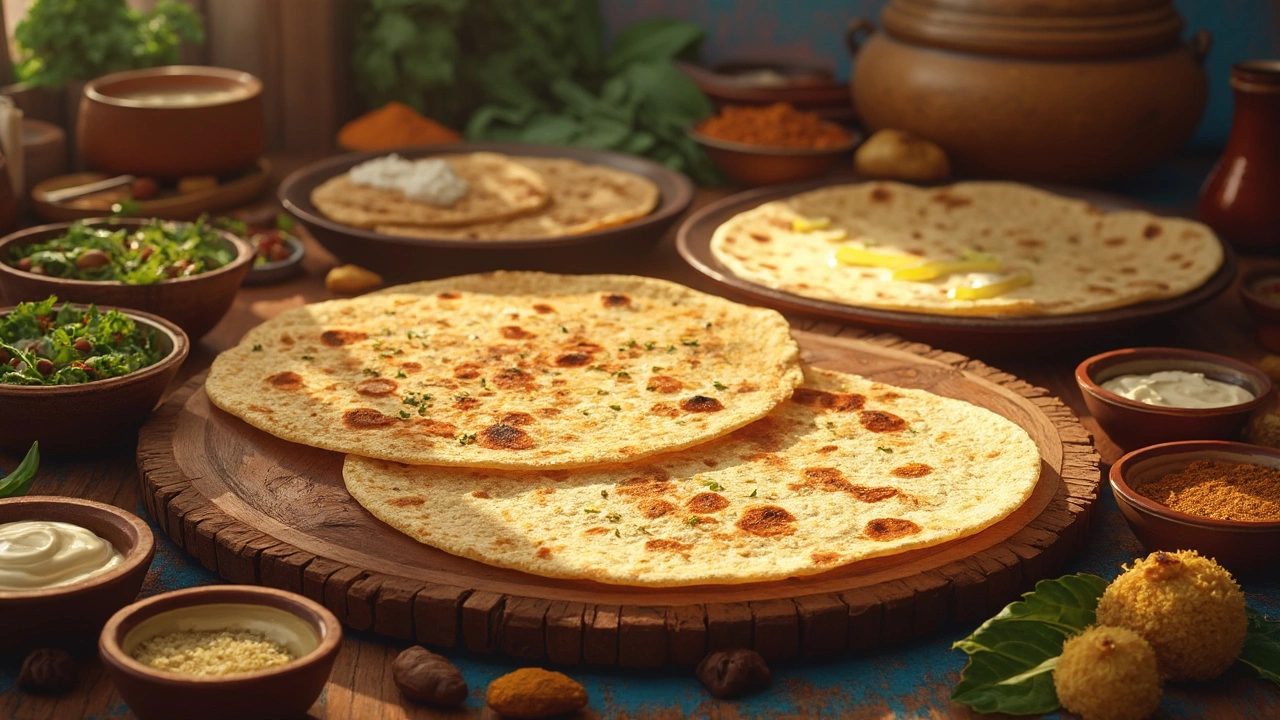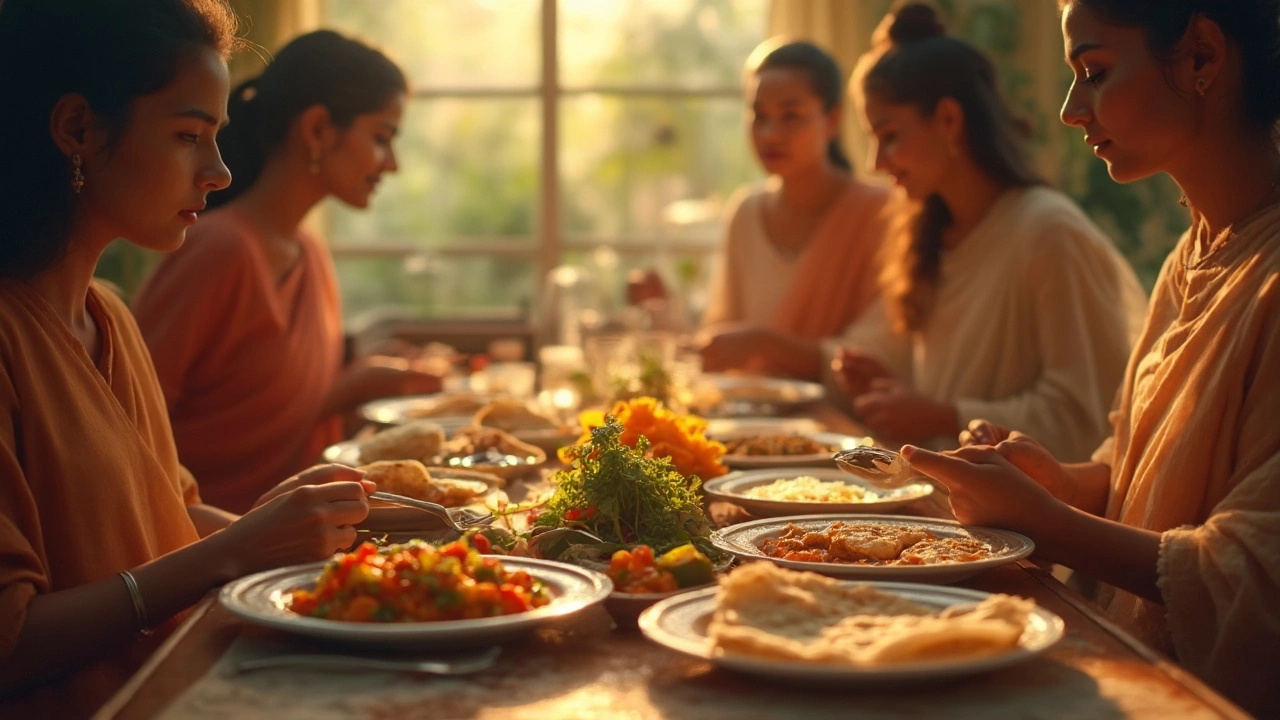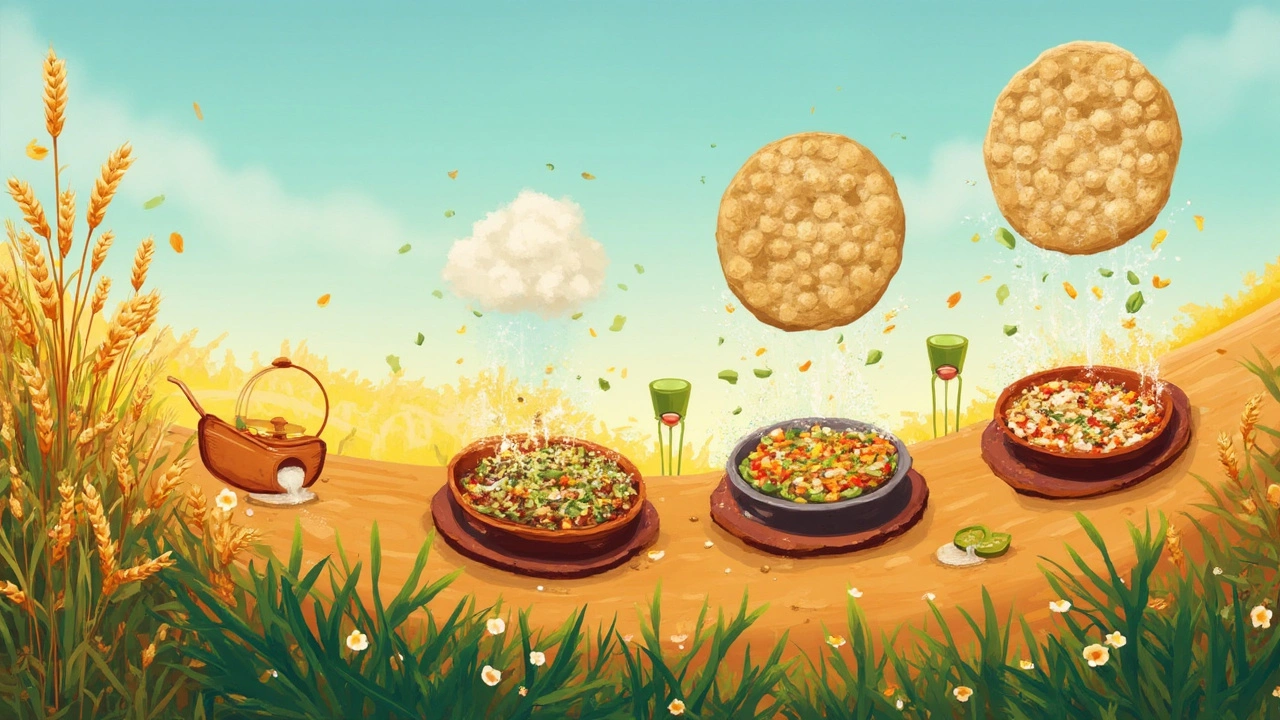Calories in 1 Roti: Unveiling the Nutritional Facts
 Feb, 18 2025
Feb, 18 2025
Ever wondered how much calories are in 1 roti? Whether you're keeping an eye on your diet or just curious, knowing the calorie content can be a game-changer. A standard roti, made with whole wheat flour and water, has approximately 70-90 calories. But hold on; that number can change. Add a little ghee, and you're up by an extra 100 calories. Let's be honest, ghee makes it tastier, but it adds those extra calories, which are worth noting if you're counting.
Pair your roti with a serving of sabzi, and you're looking at a meal that's both filling and nutritious. The combination of nutrients in roti and vegetables can help balance your dietary needs, but again, it adds to the calorie count — perhaps around 200-300 calories depending on your sabzi choice. Finding a balance between taste and nutrition is key here, and swapping in different flours or adding more vegetables can be a good start.
- Understanding Roti and Its Ingredients
- Calories in 1 Roti: The Numbers
- Roti with Ghee: A Caloric Delight
- Pairing Roti with Sabzi: The Complete Meal
- Making Healthier Roti Choices
Understanding Roti and Its Ingredients
If you've ever been curious about the beloved staple, roti, you're not alone. This humble flatbread is more than just a side dish—it's a dietary cornerstone for many people. To really get a handle on its nutritional value, let's break down what's usually inside a roti.
Basic Ingredients
The most traditional roti is made with whole wheat flour, known as 'atta'. Atta is rich in fiber, which aids in digestion and keeps you full. Plus, it offers a decent amount of protein. Water is the next key ingredient, helping to bind the dough together. And that's pretty much it for the basic roti - simple, right?
Optional Add-ins
Now, here's where you can get creative. Some people add a pinch of salt or even a touch of oil to improve texture and taste. Ever heard of adding yogurt to your dough? It makes the roti softer and even slightly ups the protein content. But be mindful; extras can add calories. We know how tempting it is to slather on ghee for that buttery flavor. It tastes heavenly but remember, ghee increases the calories in roti with ghee, too!
Types of Flour
Sure, whole wheat is the classic choice, but what if you want to experiment? Try swapping in different flours like bajra or jowar for a nutritional twist. These can add unique flavors and help mix up your nutrient intake.
DIY Roti: A Simple Guide
- Start with two cups of whole wheat flour.
- Add water gradually, mixing until you form a smooth dough.
- Let it rest for 15 minutes to soften.
- Shape into small balls and roll them out.
- Cook each side on a hot tawa until golden.
Problem and Solution
One common issue is ending up with hard rotis. Keep your dough moist but not sticky. If you're worried about calories, stick to whole wheat and avoid the ghee. Remember, each change you make can alter how much calories in 1 roti you consume, but the choice is always yours.
Calories in 1 Roti: The Numbers
So, you're curious about calories in 1 roti. Let's break it down. A standard roti, made from whole wheat flour, measures up to about 70-90 calories. This count is based on an average size roti weighing approximately 40 grams. But, remember, size and ingredients can change these numbers.
You might ask, what's inside a basic roti? It's typically made from three simple ingredients: whole wheat flour, water, and a little bit of salt. Some folks add oil during kneading which, as you guessed, hikes up the calorie count. To give you a better perspective, here's a quick breakdown:
| Ingredient | Calories |
|---|---|
| Whole Wheat Flour (40g) | 140 |
| Water | 0 |
| Oil (optional, 1 tsp) | 40 |
Wondering about the health aspect? The whole wheat flour in roti packs a punch with fiber, helping with digestion and making you feel full. But if you're looking to watch your calorie intake, measure your portions carefully or try rolling thinner rotis.
How to Adjust Caloric Intake
- Use Less Oil: Skip the oil or minimize it to cut down on extra calories.
- Mind Your Portions: Smaller rotis mean fewer calories, simple as that.
- Switch Flour Types: Mixing in other flours like ragi or jowar can dial down the calories but keep the nutrition high.
Ultimately, understanding how many calories in 1 roti helps you make smarter eating decisions, blending taste with health. Balance it out by pairing with nutritious sides and stay informed!

Roti with Ghee: A Caloric Delight
Adding ghee to a roti is a classic way to enhance its flavor and texture. While it undoubtedly elevates the taste, it also increases the calorie count substantially. A teaspoon of ghee adds around 45 extra calories to your standard calories in 1 roti, taking it close to 135-150 calories per piece. But before you skip the ghee, let's weigh the pros and cons.
Ghee, known for its rich buttery flavor, is more than just extra calories. It's a source of healthy fats and essential vitamins like A, D, E, and K. Here’s how you can enjoy it without going overboard:
Mindful Usage Guide
- Measure before you pour: Use a spoon to serve ghee, ensuring you’re aware of how much you’re adding.
- Customize the amount: Start with half a teaspoon per roti and gradually adjust to your taste preference.
- Substitute when needed: Use healthier fats like olive oil occasionally to mix it up.
For those setting specific caloric targets, moderation is the key. Let’s be real, though—a dollop of ghee blooms the roti's taste and sometimes, it’s worth indulging.
Balancing Act
Balancing taste and health can be tricky. If you're someone who just can't do without ghee in your roti, embrace it in controlled portions.How many calories in 1 roti with ghee can depend on this balance. If you fear overindulgence, save it for special meals.
Healthy eating doesn’t mean compromising on taste. It's about making choices that make meals both enjoyable and nourishing. Enjoy that calories in 1 roti with ghee without guilt, knowing you’ve incorporated it smartly into your diet. Remember, happiness in eating is also a part of a healthy lifestyle!
Pairing Roti with Sabzi: The Complete Meal
Combining roti with sabzi is like hitting a perfect blend of taste and nutrition. It forms a staple in many households, loved for its simplicity and health benefits. So, what makes this combo so special, and how can you make it healthier?
Why Pairing Works
On its own, roti is a great source of carbohydrates. When paired with sabzi, typically a vegetable dish, you add a variety of nutrients like fiber, vitamins, and essential minerals. This mix can boost your meal's nutritional value, making it more balanced and fulfilling. Ever noticed how a full meal keeps you going longer? That's because each component complements the other, working together like a well-oiled machine.
How Many Calories in 1 Roti with Sabzi?
The calorie count in 1 roti with sabzi can vary. A simple aloo sabzi (potato curry) with roti can pack around 150-300 calories per serving. Meanwhile, a lighter option, like palak sabzi (spinach), might keep it closer to 120-180 calories. The difference lies in the ingredients: potatoes and oil add more calories compared to leafy greens.
Making Healthier Choices
Want to cut down on calories without sacrificing taste? Here are some tips:
- Switch up the flour: Try using multigrain or almond flour for your roti for added nutrients.
- Less oil, more flavor: Use spices like cumin, turmeric, or coriander to add taste to your sabzi instead of extra oil.
- Bulk up with veggies: Add seasonal veggies to your sabzi to enhance nutrition and reduce calorie density.
Create a Balanced Plate
Serving a plate with the right proportions can be a game-changer. Aim for one-fourth of your plate with roti, half with vegetables, and the remaining fourth with a protein source like dal or beans. This can keep the meal both satisfying and nutritious.
Of course, you can't forget taste. After all, food is not just fuel; it's enjoyment. So, make your sabzi with a hint of spices and your roti fresh and warm. There's no better comfort food!

Making Healthier Roti Choices
Everyone loves a good roti, but sometimes we worry about the calories in 1 roti. It's easy to make small changes that can help keep things healthier without losing that classic taste. So, how do you do it?
Choose the Right Flour
First up, consider the flour you're using. Whole wheat is common, but mixing in some multigrain or millet flour can bump up the fiber and nutrients, keeping you full longer without a big jump in calories in 1 roti.
Simplify with Cooking Spray
Love the taste of ghee but want to cut back on calories? Try using a cooking spray. You still get the flavor without all the extra calories from ghee. This can save you around 50-100 calories right there.
Add Extra Nutrition with Ingredients
Why not jazz up your roti dough with some extras? Think spinach, fenugreek, or even grated vegetables. Adding these can increase the vitamins and minerals in your meal, keeping it both fun and beneficial.
Control Your Portions
Ever thought about the size? The smaller the roti, the less it's going to add to your calorie counter. With how much calories in 1 roti always on our minds, sizing down can mean enjoying multiple smaller rotis for the calorie price of one big one.
DIY Roti Tips
- Mix flours to balance flavor and health benefits.
- Use non-stick surfaces to reduce oil or ghee usage.
- Integrate herbs and spices directly into the dough for added taste without calories.
Making these small tweaks can lead to big differences in your meals while keeping them satisfying. Go ahead, experiment, and find your personal favorite mix!